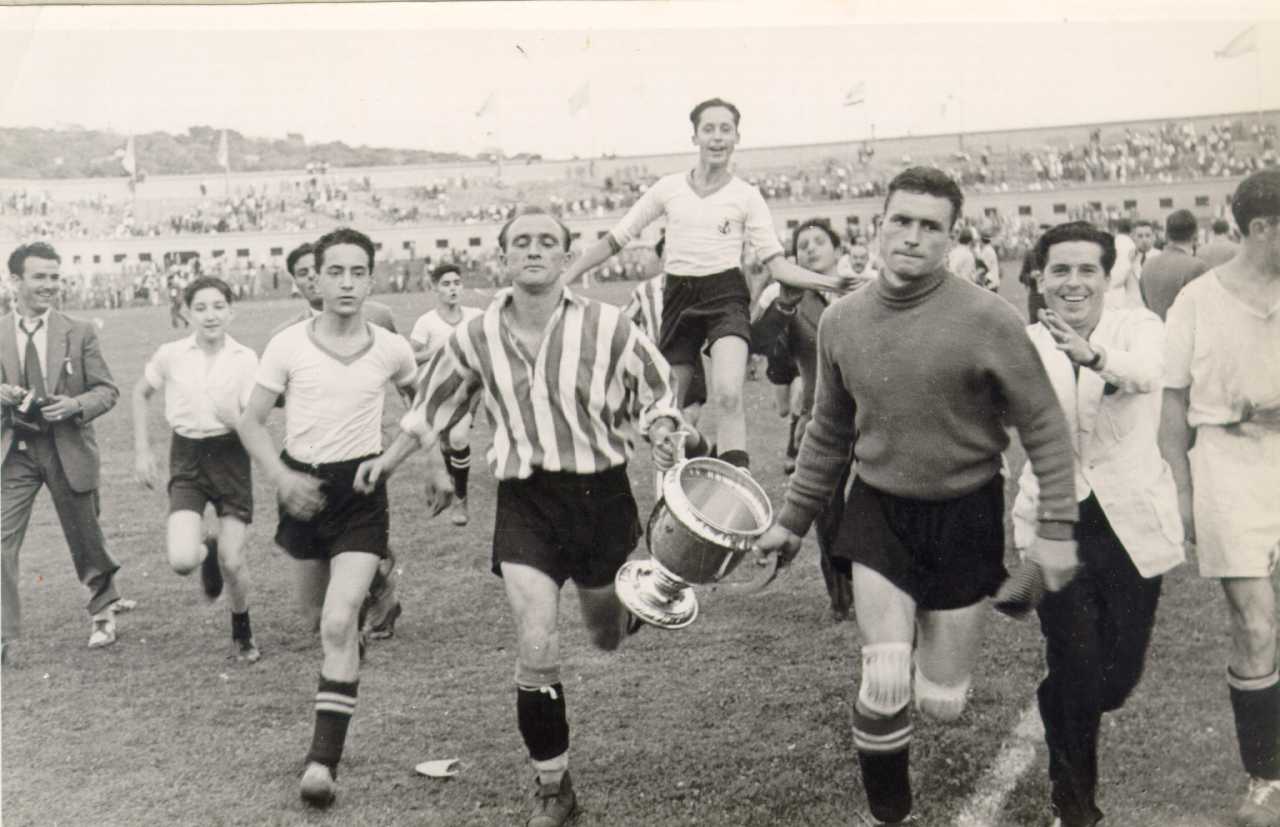
The Children of 37 (pt.3): Raimundo Lezama
The Children of 37 (pt.3): Raimundo Lezama
After making a name for himself at Southampton FC, Raimundo Lezama returned to Athletic Club and became a legend
“The Children of ’37 in the UK”, the AC Museum’s upcoming exhibition, explores the evacuation of 4,000 Basque children to England aboard the SS Habana during the Spanish Civil War. More specifically, it follows the story of those refugees who developed a passion for football in the United Kingdom.
The exhibition’s inauguration is due to take place at midday local time on April 27, one day after the 85th anniversary of the bombing of Gernika.
As we get closer to the exhibition’s opening, we are publishing a three-part feature series taking an in-depth look at the small number of Basque refugee children who overcame the adversity of their respective situations and excelled as footballers, achieving extraordinary feats in their careers.
This third and final part of our series is dedicated to Raimundo Pérez Lezama.
On May 4, 1940, a 17-year-old Lezama got his first taste of senior football, taking his place between the sticks for Southampton in a 5-1 friendly loss against Chelmsford City FC.
Despite the defeat and a mistake made by Raimundo for the opening goal, local papers singled out his “splendid exhibition” in goal, while post-match Saints manager Tom Parker reiterated his belief Lezama “would develop into a top-class goalkeeper”. Parker’s prediction was spot on.
Raimundo Pérez Lezama fled his hometown of Barakaldo in May 1937, escaping to England aboard the SS Habana with 4,000 other children. Four years later he returned to Biscay and joined Athletic Club. In a remarkable career, he won eight trophies and made 263 appearances in 16 seasons for his boyhood team, all while blazing a trail for a new and innovative style of goalkeeping.
Upon arriving in the south coast city with his younger brother Luis, and after a brief stay at North Stoneham Camp in Eastleigh, Raimundo was sent to live in Nazareth House.
It was at Nazareth House, barely 200 metres away from Southampton FC’s ground, The Dell, that Raimundo and Sabino Barinaga began to stand out for their footballing ability. Toby Keleher, Commander in the RAF and board member at Southampton, suggested that Saints manager Tom Parker should take the boys on trial.
They were soon brought into the Saints’ youth set-up. Originally, Lezama was an outfield player, but after a while he established himself as Southampton reserves’ no.1, Parker saying he was “as agile as a cat”.
With the onset of WWII and the decimation of their playing squad, Southampton limited themselves to an ‘A’ team and a senior side for the wartime competitions. Lezama soon progressed to the top squad and made several appearances, playing against the likes of Arsenal, Fulham and Charlton.
The club were desperate to keep hold of both Lezama and Barinaga, but they were refused permission by the UK Home Office, who wanted to send back as many of the refugees as possible after the end of the Spanish Civil War.
Lezama signed for Arenas de Getxo soon after his return, but he was quickly snapped up by Athletic Club, signing for the Bilbao side ahead of the 1940/41 campaign. Fierce competition for the no.1 spot meant Lezama was forced to wait for his opportunity at the Lions. It came in September 1942, Raimundo stepping in for Josetxu Echebarria after the latter developed a severe lung infection.
Lezama never looked back, holding on to the spot for the next decade or so. Raimundo introduced the domestic game to a style of goalkeeping it had not really encountered before. In addition to his shot-stopping prowess, he would come out of his area, play quick passes with his feet and launch counter attacks with long throws. Essentially, he was a proto sweeper-keeper.
It is said local referees were so confused by his antics they would ask him to return to the 18-yard box, unsure if goalies were actually allowed to leave their area as nobody had ever done it before.
One of his career-defining performances came in the 1942/43 Copa del Rey final victory over Real Madrid. Curiously, it also saw him go up against his old friend, Sabino Barinaga. Lezama was sensational in goal. Match reports highlighted his “monumental work marshalling his area, intercepting crosses and preventing Madrid from gaining possession”.
Athletic won the Copa and Liga double that season. Lezama went on to win a total of eight trophies with Los Rojiblancos, which included: two LaLigas (42/43, 55/56) and six Copas (42/43, 43/44, 44/45, 49/50, 54/55 and 55/56).
By the time the 1950s came around, Carmelo Cedrún’s emergence saw Lezama’s game time decrease. At the end of the 56/57 season, Raimundo decided to hang up his boots, but he reconsidered when a friend asked him to turn out for SD Indautxu. He spent a further four seasons playing lower-league football with various clubs before calling time on his career in 1960/61.
Raimundo Pérez Lezama passed away in July 2007, but he has always remained a much-beloved figure at Athletic Club. The pedestrian street which runs adjacent to San Mamés’ North Stand is named in his honour, it is one of only three streets in Bilbao named after a former Athletic player.
KEEP READING 👇
